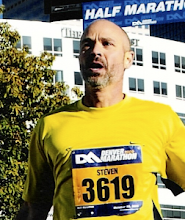Follow the Directions
Friday, January 29, 2010
Looking back on my 11 weeks of marathon training, one thing that has become clear to me is just how little I knew when I started. I knew how to do an interval workout, a tempo run, and I was doing long runs of 11 miles or so on a regular basis. But I didn't know how to put all of that together in to a plan designed to achieve a specific goal. I didn't really understand how significant an impact hills and snow could have on effort. And even though I carried water and gels on my long runs, I didn't have a good handle on how to stay hydrated and fueled. For the last few weeks, one thing I knew I didn't understand was how to recover from a long run of more than 15 miles.
I'm not even sure how I knew I didn't know. Maybe I'm giving myself too much credit. What I do remember was a desire to remove Gatorade from my post run routine. Not that there is necessarily anything wrong with Gatorade, but I didn't really want the high fructose corn syrup (despite marketing efforts from the Corn Refiners Association). That lead me down a path of trying to evaluate the various carb replacement drinks out there - from Clif, to Accelerade, to Shaklee's Performance Sports Drink. And then there's the debate about carbs versus carbs plus a specific amount of protein. And there's cost. Some of this stuff is very expensive.
I even came across some recommendations to drink chocolate milk. That sounded good to me, but what should I be doing? (Seems like I've been having that question a lot lately - see
What am I Supposed to Do.) I knew that after a long run, sometimes I experienced mild cramping for a few hours leaving me not really wanting to eat. But I was pretty sure I needed to eat something. And then there was the incredible need to nap. A couple of hours after finishing, it was really difficult to keep my eyes open. Was that normal?
At some point in the process I went out to Greg McMillan's website to see if he had anything to say about it. And sure enough he did - The Runner's Ultimate Nutritional Recovery Routine (RUNRR). Not only did it sound like exactly what I was looking for, there was something oddly familiar about it. It was the acronym - RUNRR. I knew I had seen that before, but when? Where? Then it hit me. I pulled up the spreadsheet with my custom training plan from Greg and sure enough - pretty much 3 times a week RUNRR was in the comments section for the day's workout.
Every speed workout, every stamina workout and every long run had RUNRR in the comments. You really should read the article yourself, but here is essence of it. After a strenuous workout you should be following a very specific nutritional routine to aide your recovery and prepare you for the next workout. Basically, within 2 hours of completing your workout, you need to consume about 1 gram of carbohydrate for every pound of body weight, with a gram of protein for every 4 grams of carbs. So for someone my size, at 145 lbs, you need to eat 145 grams of carbs and 36 grams of protein. If done in the right ratio, the food will be readily absorbed and prepare you for future runs.
Greg gives some ideas about what to eat to do this and what he uses. He also has found that he does best when consuming 1/2 of the carbs and protein within the first 30 minutes. There is some science behind all of this, including the 30 minutes, but I'll let you read about that.
So now that I knew what the plan was, it was pretty easy to decide on how to achieve it. I decided the chocolate milk thing sounded good. I put together a spreadsheet that allowed me to calculate the combined carbs and protein of milk and Nestle's Nesquick (uses sugar and not high fructose corn syrup). Turns out that 18 ounces of milk with 6.5 tablespoons of Nesquick gives me half of my needed carbs (72) with the right amount of protein (18). And you know what - it tastes really good right after a hard run. And I don't get any cramping. And as a bonus, it costs less than half of any of the commercial carb drinks.
I do struggle to get the rest of the food in me before the 2 hours is up. That's a lot to eat. But I can tell that my body is responding well to the routine - both in terms of how I feel that day and how my body feels the next day. And you know what, Greg also mentions that he takes a two hour nap on his long run days. I guess it is normal to feel sleepy after running 20 miles.
And all that just goes to show how little I knew about this when I got started. And one other thing. It also points out how important it is to understand the advice given by knowledgeable people. Greg had told me several weeks ago through my training plan how to recover after my hard runs - he specifically put RUNRR next to each one. And to be honest, I saw the RUNRR on the training plan. And what's worse, I figured it meant something, but I never took the time to try to figure out what.
Now that I think of it, my wife is often asking me, "don't you think you should Follow the Directions?" And once again, she'd be right.

0 comments:
Post a Comment